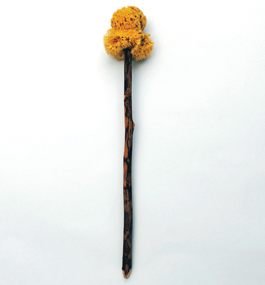Massive Relief

D. Herdemerten
COMMUNITY PROPERTY: Replica of a Roman latrine’s sea-sponge-on-a-stick.
During the late first century B.C.E., Rome started to experience urban sprawl. As the city’s footprint and population expanded, temples, circuses, amphitheaters, forums and baths began to proliferate.
So did public latrines. If nature called, you were pretty much covered, regardless of where you were. But, however happy you were that it was close by, a public latrine wasn’t necessarily a place you’d want to linger.
In the forthcoming book “66 Toilets and Urinals in the Ancient City of Rome: Sanitary, Urbanistic and Social Agency,” Ann Olga Koloski-Ostrow, her two co-editors and the book’s contributors plumb the depths of urban hygiene and sanitary engineering in the caput mundi (capital of the world).
Roman latrines, or foricae, were part of a sophisticated, interconnected public sanitation system of aqueducts, baths and sewers. According to literary and archaeological evidence, most foricae were not for the modest, the timid or the olfactorily sensitive.
Usually rectangular in shape, a forica consisted of a marble or stone slab running like a bench along an interior wall. This bench was punctuated by enough regularly spaced holes to seat 20, 30 or even 50 people, all within inches of each other. A gutter underneath connected to the city sewers and was “flushed” with previously used water from nearby baths. Small windows made for dim light and poor ventilation. The open connection to the sewer system meant latrines were, indeed, odiferous.
Perhaps most challenging to our modern sensibility (not to mention our understanding of germs and infection) was the communal sea-sponge-on-a-stick that passed for toilet paper, which patrons rinsed in water flowing in a trench in the floor.
Some public latrines were relatively grand, featuring statuary, frescoed walls and mosaic floors. Many boasted a wall painting of Fortuna, the goddess of good luck, to whom you might pray for things to go smoothly, so to speak. You might also pray for protection from assault by a fellow latrine patron or, worse, from being bitten by a rat or some other creature crawling up from the sewer while you sat on the throne.
The domestic toilet, or latrina, was more private but less sophisticated. Basically an open cesspit, it was often located near the kitchen so it could double as a convenient place to throw food scraps. Because latrinae were often not connected to the sewer system (see “rat,” above), their contents had to be removed on a regular basis — an unhealthy process that exposed the cesspit cleaner to all manner of pathogens.
Koloski-Ostrow has spent her career delving into these sanitary realities. It’s not, she’s quick to point out, to deride ancient Romans or amuse modern readers. Instead, it’s to expand what we know about Romans’ perspectives on public health, public order and civic administration.
A graffito scrawled on a house, for example — written at a time when doing your business in the street was no longer being tolerated — shows Romans’ evolving take on sanitation: “To the one defecating here, beware of the curse. If you scorn this curse, you will have angered Jupiter.”
Furthermore, rather than viewing human ordure as purely noxious, Romans recycled it, turning both urine and excrement into fertilizer.
And that’s just the beginning. In his “Natural History,” Pliny the Elder catalogs many other uses for human and animal excreta, including as cures for baldness, itching and gout; as relief from burns and sprains; and, intriguingly, as an aphrodisiac.
— S.C.B.
